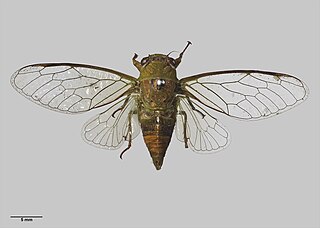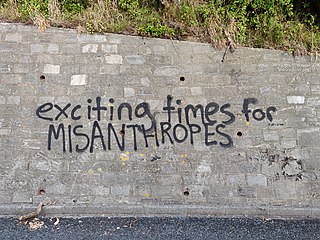New Zealand English (NZE) is the variant of the English language spoken and written by most English-speaking New Zealanders. Its language code in ISO and Internet standards is en-NZ. It is the first language of the majority of the population.

The North Island is one of the two main islands of New Zealand, separated from the larger but less populous South Island by Cook Strait. With an area of 113,729 km2 (43,911 sq mi), it is the world's 14th-largest island, constituting 43% of New Zealand's land area. It has a population of 3,997,300, which is 77% of New Zealand's residents, making it the most populous island in Polynesia and the 28th-most-populous island in the world.

The New Zealand Order of Merit is an order of merit in the New Zealand royal honours system. It was established by royal warrant on 30 May 1996 by Elizabeth II, Queen of New Zealand, "for those persons who in any field of endeavour, have rendered meritorious service to the Crown and nation or who have become distinguished by their eminence, talents, contributions or other merits", to recognise outstanding service to the Crown and people of New Zealand in a civil or military capacity.

Auckland City Football Club is a New Zealand semi-professional football club based in the suburb of Sandringham in Auckland, New Zealand. They currently compete in the Northern League. Auckland City have established themselves as a major force in both New Zealand and Oceania, having won nine New Zealand Football Championship titles and twelve OFC Champions League titles since their foundation.

New Zealand is an island country in the southwestern Pacific Ocean. It consists of two main landmasses—the North Island and the South Island —and over 700 smaller islands. It is the sixth-largest island country by area and lies east of Australia across the Tasman Sea and south of the islands of New Caledonia, Fiji, and Tonga. The country's varied topography and sharp mountain peaks, including the Southern Alps, owe much to tectonic uplift and volcanic eruptions. New Zealand's capital city is Wellington, and its most populous city is Auckland.

Kikihia is a genus of cicada in the family Cicadidae. Most species contained in the genus are endemic to New Zealand, with a single Australian species found on Norfolk Island. The genus was established in 1972 by John S. Dugdale with eleven species formerly classed within the genus Cicadetta.

Auckland is a large metropolitan city in the North Island of New Zealand. It has an urban population of about 1,478,800. It is located in the greater Auckland Region, the area governed by Auckland Council, which includes outlying rural areas and the islands of the Hauraki Gulf, and which has a total population of 1,739,300 as of June 2023. It is the most populous city of New Zealand and the fifth largest city in Oceania. While Europeans continue to make up the plurality of Auckland's population, the city became multicultural and cosmopolitan in the late-20th century, with Asians accounting for 31% of the city's population in 2018. Auckland has the fourth largest foreign-born population in the world, with 39% of its residents born overseas. With its large population of Pasifika New Zealanders, the city is also home to the biggest ethnic Polynesian population in the world. The Māori-language name for Auckland is Tāmaki Makaurau, meaning "Tāmaki desired by many", in reference to the desirability of its natural resources and geography. Tāmaki means "omen".

Dame Jacinda Kate Laurell Ardern is a former New Zealand politician who served as the 40th prime minister of New Zealand and leader of the Labour Party from 2017 to 2023. She was a Labour member of Parliament (MP) as a list MP from 2008 to 2017, and for Mount Albert from 2017 to 2023.

Māori are the indigenous Polynesian people of mainland New Zealand. Māori originated with settlers from East Polynesia, who arrived in New Zealand in several waves of canoe voyages between roughly 1320 and 1350. Over several centuries in isolation, these settlers developed their own distinctive culture, whose language, mythology, crafts, and performing arts evolved independently from those of other eastern Polynesian cultures. Some early Māori moved to the Chatham Islands, where their descendants became New Zealand's other indigenous Polynesian ethnic group, the Moriori.

Palpada is a genus of 85 neotropical and nearctic flower flies or hoverflies This genus is often colorful and bee-like. It is in the tribe Eristaliini containing dozens of genera Common sister genera include Eristalis (99 species), Meromacrus (43 sp.), Eristalinus (100 sp.) and Helophilus (50 sp.). The genus palpada is distinguished by:

Lydia Ko is a New Zealand professional golfer and the reigning Olympic champion. She first reached number one in the Women's World Golf Rankings on 2 February 2015 at 17 years, 9 months and 9 days of age, making her the youngest player of either gender to be ranked No. 1 in professional golf.

Onychohydrus is a genus of beetles in the family Dytiscidae. The genus is found in Australia, Tasmania, and New Zealand's North Island. The genus consists of these two species:

Kikihia ochrina is a species of insect endemic to New Zealand. This species has a three-year life cycle and adults are bright green in colour and are most commonly seen in the month of April in the North Island.

Kikihia scutellaris, commonly known as lesser bronze cicada, is a species of cicada that is endemic to New Zealand. This species was first described by Francis Walker in 1850.

Two consecutive mass shootings took place in Christchurch, New Zealand, on 15 March 2019. They were committed by a single perpetrator during Friday prayer, first at the Al Noor Mosque in Riccarton, overlooking Hagley Park, at 1:40 p.m., and second, after driving at speed across town, at the Linwood Islamic Centre at 1:52 p.m.
The COVID-19 pandemic in New Zealand was part of the pandemic of coronavirus disease 2019 caused by severe acute respiratory syndrome coronavirus 2. The first case of the disease in New Zealand was reported on 28 February 2020. The country recorded over 2,274,370 cases. Over 3,000 people died as a result of the pandemic, with cases recorded in all twenty district health board (DHB) areas. The pandemic first peaked in early April 2020, with 89 new cases recorded per day and 929 active cases. Cases peaked again in October 2021 with 134 new cases reported on 22 October.

The global COVID-19 pandemic had a significant impact on the New Zealand economy. New Zealand has a mixed economy – a free market with some state ownership and control. In mid-March 2020, the New Zealand Government imposed a four-tier alert level system, which placed much of the country's economy into lockdown with the exception of "essential services" such as supermarkets. Due to the success of the Government's elimination strategy, lockdown restrictions on various economic activities were progressively lifted between April and June 2020.

The COVID-19 pandemic in New Zealand has had far-reaching consequences on the country that went beyond the spread of the disease itself and efforts to eliminate it, including education, faith communities, Māori, mass gatherings, sports, recreation, and travel. In addition, there were several recorded cases of lockdown violations, leaks, and misinformation about the COVID-19 virus and vaccines.

COVID-19 vaccination in New Zealand began on 20 February 2021, and will continue throughout the pandemic with the goal of vaccinating all willing New Zealanders aged 5 or older. Those aged 5 to 11 require a parent, caregiver or legal guardian accompany them to their appointment and provide consent for them to be vaccinated. As of 1 September, anyone in New Zealand, regardless of their immigration status, is eligible to be vaccinated.
















